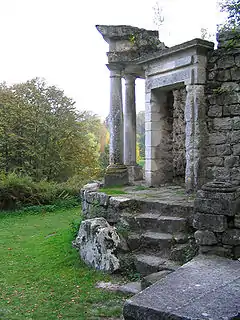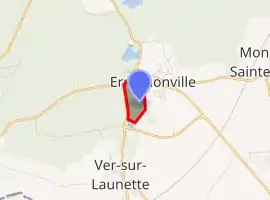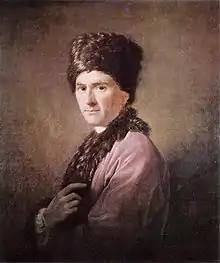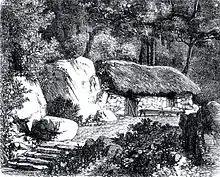Parc Jean-Jacques Rousseau
The Parc Jean-Jacques-Rousseau is a French landscape garden at Ermenonville, in the Département of Oise. It is named for the philosopher Jean-Jacques Rousseau, who stayed there the last six weeks of his life. He died there in 1778 and was buried in an island in the park. The western part, called "le Désert" is managed by the Institut de France, and the northern part by a hotel/restaurant at the Château d'Ermenonville. The other parts are not open to the public, for various reasons.
| Parc Jean-Jacques Rousseau | |
|---|---|
 The Temple to Philosophy, inspired by Rousseau, a cenotaph | |

| |
| Location | Ermenonville, France |
| Coordinates | 49°7′16″N 2°41′28″E |
| Created | 1765–1776 |
| Website | http://www.oise.fr/culture-et-vie-locale/le-parc-jean-jacques-rousseau/ Conseil général de l'Oise |
History
The park at Ermenonville was created by René de Girardin (1735–1808). Girardin was an officer under Stanislas Leszczyński, and fought in the Seven Years' War. Girardin acquired a substantial inheritance from his mother René Hatte in 1762, enabling him to create his park and gardens at Ermenonville.[nb 1] Girardin brought in two hundred English workers to create his garden.
It was inspired by Jean-Jacques Rousseau's philosophy, in his 1761 work, Julie, or the New Heloise, drawing from the works of the English writers Joseph Addison, Alexander Pope and Anthony Ashley-Cooper, 3rd Earl of Shaftesbury,[a 1] all three of whom had written on English gardens.
Girardin laid out the garden based on ideas expressed in an essay entitled De la composition des paysages sur le terrain ou des moyens d'embellir la nature près des habitations en y joignant l'agréable à l'utile ("On the creation of landscapes, or means of embellishing nature near inhabited places in merging the agreeable and the useful"). [a 2]
.jpg.webp)


In the 1770s Rousseau and Girardin met up in Paris.[1] In the spring of 1778, his friend Thérèse Levasseur fell into bad health, and her doctor advised her to have a rest in the countryside. The two then tried to find a new place to live.[a 3]
Girardin, one of Rousseau's many admirers, invited them to stay at a cottage in his garden, and they did from May 1778.[c 1] There, Rousseau recovered his extroadinary enthusiasm for nature. As he said to his friend Girardin: "For a long time, my heart drew me here, and what my eyes see, make me want to stay here always".
On 4 July 1778, Rousseau was buried at midnight, by torchlight, on a little island in the park which now bears his name. His remains were ceremonially relocated to the Panthéon national heroes repository in Paris in 1794.
On 26 December 1787, a violent storm devastated parts of the park, which were only partly repaired.[2]
Reception
The park was considered one of the foremost English-style parks on the Continent, remarkable "for the landscapes it offered to visitors and the reflections it inspired in the course of a ramble".[a 3]
It was visited in its early years by several prominent people, including Emperor Joseph II of Austria in 1777, Queen Marie-Antoinette in spring 1780, King Gustave III of Sweden in 1783 and First Consul Napoléon Bonaparte, several times beginning in 1800.,[3] Benjamin Franklin and Maximilien de Robespierre.[4]
Notes
- Curtil, Jean-Claude (1978). Ermenonville : La glaise et la gloire ("Ermonville, grace and favour"). La Ferté-Macé: Bernard Gallier. pp. 66–67.
See also
| Wikimedia Commons has media related to Parc Jean-Jacques-Rousseau. |
Bibliography
- Curtil, Jean-Claude (1978). Bernard Gallier (ed.). La glaise et la gloire. La Ferté-Macé. Ermenonville. p. 153.
- Dumas, Catherine (2001). Ermenonville: un paysage philosophique; dans : Géographie et cultures, n° 37. Paris: L'Harmattan. p. 144. ISBN 2-7475-0586-3. Dumas2001., p. 59-80.
- Mathieu, René (1970). Nouvelles éditions latines (ed.). Parc d'Ermenonville. Paris.
- Mazel, Geneviève (1996). Groupe d’Étude des Monuments et Œuvres d’art de l’Oise et du Beauvaisis (GEMOB) (ed.). Ermenonville : l'histoire et la vie du village, le château et les jardins du marquis de Girardin, le souvenir de Jean-Jacques Rousseau: bulletin spécial n°73-75. Beauvais (60). ISSN 0224-0475.CS1 maint: location (link)
- Rahal, Baptiste; Lartillot (photography), Christian (2005). Conseil général de l'Oise (ed.). Vers le parc Jean-Jacques Rousseau. Beauvais. ISBN 2-11-095732-8.
- Volbertal, J.-Henri (1923). Imprimeries réunies de Senlis (ed.). Ermenonville ses sites ses curiosités son histoire. Senlis.
- Anonymous (text); Mérigot fils (gravures) (1788) [original 1783]. Promenade ou itinéraire des jardins d'Ermenonville. Paris. p. 72. AuteurAnonyme1783. (link Google Books)
References
- Michaud (ed.). Biographie universelle ancienne et moderne. XVI. Paris. p. 549.
- Cf. "Le parc Jean-Jacques Rousseau". Retrieved 26 December 2010. sur le site "Parques à fabriques"..
- Cf. Les environs de Paris illustrés, op. cit., p. 368.
- Cf. Parc d'Ermenonville, op. cit., p. 19.
- Catherine Dumas (2001). Ermenonville: un paysage philosophique. (voir dans la bibliographie)
- p. 62
- Victor Hugo (1993,1998), Collins Concise Dictionary of Quotations, Collins, ISBN 0-00-434350-6 Check date values in:
|date=(help) - p. 59
- anonymous (1783). Promenade ou itinéraire des jardins d'Ermenonville. (voir dans la bibliographie)
- J.-Henri Volbertal (1923). Ermenonville ses sites ses curiosités son histoire. (voir dans la bibliographie)
- p. 16
External links
- Description du parc Jean-Jacques Rousseau avec plan
- Parc Jean-Jacques Rousseau (Google Maps), the indicator points out the Petit Parc, south of the Rue Réné-de-Girardin. There is no geographic label for the château d'Ermenonville on this map.